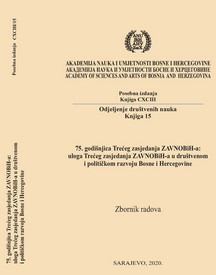ZAŠTO JE DOŠLO DO PROMJENE POLITIKE ODNOSA PREMA RELIGIJI I CRKVI NEPOSREDNO NAKON DRUGOG SVJETSKOG RATA
WHY WAS THERE A CHANGE IN THE POLICY OF RELATION TO RELIGION AND THE CHURCH IMMEDIATELY AFTER THE SECOND WORLD WAR
Author(s): Ivan Cvitković
Subject(s): History of Church(es), Political history, Government/Political systems, Politics and religion, WW II and following years (1940 - 1949), Post-War period (1950 - 1989)
Published by: Akademija Nauka i Umjetnosti Bosne i Hercegovine
Keywords: National Liberation Movement; ZAVNOBiH; religion; Church; war;
Summary/Abstract: A little bit about the relation of the National Liberation Movement (NLM) towards religion and religious communities: most members of the Movement were not Communists; the Communists were the organisers of the anti-fascist struggle; what the NLM fought for, the National Liberation Front (NLF) policy; introduction of the title of religious officers among fighters; examples of the National Liberation Movement attitude towards freedom of religion; freedom of religious education; establishment of the „Religious Commission“... On religion and the Church at the Third Session of ZAVNOBiH: religious officials at the session; analysis of discussions that critically reviewed religion and religious communities; election of priests in ZAVNOBiH. Where did it go wrong? Why have there been changes in attitudes towards religion and the Church? The beginnings of intolerance: mutual actions (of the authorities and religious communities) that led to the deterioration of relations. What bothered religious communities? What motivated authorities to change their policy and tighten attitudes towards religious communities?
- Page Range: 231-240
- Page Count: 10
- Publication Year: 2020
- Language: Bosnian, Croatian, Serbian
- Content File-PDF

